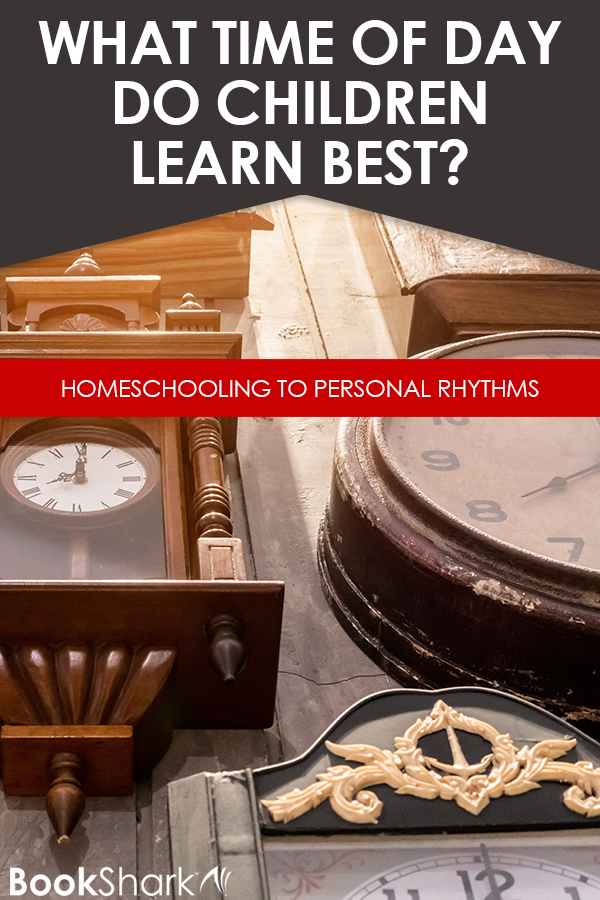




What is the Best Time of Day to Learn for Children? Homeschooling to Personal Rhythms

For our family, paying attention to time is a huge piece of why we homeschool:
- having enough time for things we love
- spending time together
- learning at the times when we feel our best
I homeschool because I want my children to have time to learn and follow their passions. For us, this means we don’t follow a traditional school schedule. Depending on the day, season, year and the outside classes my children take, our learning might happen in the early morning or late afternoon.
I’ll be honest. Sometimes I love our rhythm, and other times it’s challenging. I’m a morning person and prefer to get going right away. My nine-year-old is a night owl and has been since birth. Her creative juices get going about bedtime.
While I am not willing to practice math facts late into the night, a recent question in a homeschool group regarding homeschooling in the evening, got me wondering: Are there certain times in the day that are better for homeschooling?
What’s the Right Time of Day to Homeschool?
Research suggests, yes, there are times in the day (or night) when our children learn best. Giving Students the (Right) Time of Day by Roger John Callan in the journal Educational Leadership discusses how looking at our circadian rhythms can help determine the best time to learn.
The only caveat is that our rhythms vary. Callan says,
"Subsequent research has confirmed that some people reach their temperature peak before noon, some in the afternoon, and some in the evening. Hence, a picture emerges of the morning person, afternoon person, and evening person."
My daughter and I are clearly on different rhythms.
So, what is the best time of day to help each individual child learn? Callan says,
“In the best of all possible worlds, each school district would have three parallel systems. The principal school for the majority of students would hold classes in the late morning through the afternoon. Two smaller schools—one open earlier in the morning and the other in the evening—would cater to the remaining students. Classes would begin just as the students began to approach their period of peak efficiency and understanding. For most students, according to the research of Dunn and Dunn (1993), that time is mid-morning—about 11 a.m. A significant number of students, however, are morning people. And there are evening people, as well.”
In the article, Does Time-of-Day of Instruction Impact Class Achievement?, Amanda J. Wile and Gary A. Shouppe, out of Columbus State University agree. They considered a number of studies centered around the best times to teach children and found, “Learning-styles research reveals increased learning occurs when a student is taught and assessed at their preferred time-of-day.”
The National Sleep Foundation also agrees but notes our circadian rhythms can change: “Changes to this circadian rhythm occur during adolescence when most teens experience a sleep phase delay. This shift in teens’ circadian rhythm causes them to naturally feel alert later at night, making it difficult for them to fall asleep before 11:00 pm.”
While finding the right time for each child to learn, might feel impossible or even be impossible considering class schedules and family needs, paying attention to our children’s circadian rhythms may add insight when kids are struggling or feeling frustrated. It might make homeschooling feel a little more doable or explain why some of our kids are paying attention during reading time and others are flipping off the couch.
In order to find the best time for our children to learn, we have to pay attention to several factors.

Pay Attention to Sleep
When does your child naturally fall asleep? When do they wake up? I have an early riser and one child that can only be compared to a snail in the morning. Is it possible to read or do math with your early bird and let your night owl sleep in a little?
While we may assume it’s easier to have everyone learning at the same time, an individual schedule for each child could make learning a lot smoother.
Pay Attention to Energy
While a child’s energy level can certainly be linked to sleep and food, they can also have times of days they need to move. My son is ready to move the second he wakes up. When he was little, we often went on morning bike rides before breakfast. We’d get home, eat, and then he was ready to learn something new in his curriculum. If I tried reading with him before he moved, he could not sit still.
Pay Attention to Hunger
I am a fan of meal times. We sit down together as a family at least once if not twice a day. My daughter is rarely hungry during these times. She picks at her food and inevitably goes back to it later, once we have all finished. For years I tried to make her eat, and for years she told me she wasn’t hungry. Finally, I listened. Now, she happily sits with us (because family time is really why we are gathering) and eats later when she is actually hungry. This, in turn, helps her feel better and our learning time goes smoother.
Pay Attention to Quiet
We all need quiet. It recharges us and actually gives us energy. For my daughter, she seeks quiet when she wakes up. It’s important I give her plenty of time to wake up, get ready, and eat breakfast. She’s happy to get up earlier if it means she has this time. Rushing her out the door is never a good idea and always starts our day badly.
Pay Attention to Focus
My son is most focused mid-morning, my daughter at mid-afternoon and evening. I’m focused early in the morning while my husband is the opposite, preferring late at night. While we can’t always learn and work during our ideal times, it’s helpful to know this about ourselves and try to accommodate when we can.
In a perfect world, our children learn when their bodies and minds are in sync. But let’s be honest, regardless of whether we are homeschooling one child or seven, it’s not always possible to give our children the exact thing they need at the exact moment they need it. Paying attention to their circadian rhythms does not mean we homeschool from dawn till dusk.
It means we pay a little more attention and use the information when and if we can. It means we recognize why our children may be having a hard time sitting still and let them take breaks or jump on the trampoline. We don’t feel discouraged if our child is reading well past bedtime, or worry as much about having everyone do math at 10 am. Paying attention to each of our children’s natural rhythms (and our own) helps us remember that we are learning at our own speed and there is no one right speed in which to learn.

About the Author
Kelly left teaching middle and high school English to homeschool her children and reclaim how she and her family spent their time. Followers of interest-led learning, her family’s days rarely look the same, but they tend to include a lot of books, art supplies, and time outside.
Kelly facilitates local writing circles for women and children and blogs about nurturing the love of learning on her blog, Curiosity Encouraged. She loves to journal, read memoirs, hike, and travel. She seeks quiet mornings and good coffee daily.